
Sonar is a technique that uses sound propagation to navigate, measure distances (ranging), communicate with or detect objects on or under the surface of the water, such as other vessels.
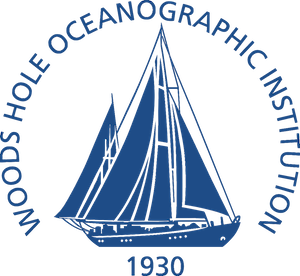
The Woods Hole Oceanographic Institution is a private, nonprofit research and higher education facility dedicated to the study of marine science and engineering.

The United States Naval Research Laboratory (NRL) is the corporate research laboratory for the United States Navy and the United States Marine Corps. Located in Washington, DC, it was founded in 1923 and conducts basic scientific research, applied research, technological development and prototyping. The laboratory's specialties include plasma physics, space physics, materials science, and tactical electronic warfare. NRL is one of the first US government scientific R&D laboratories, having opened in 1923 at the instigation of Thomas Edison, and is currently under the Office of Naval Research.
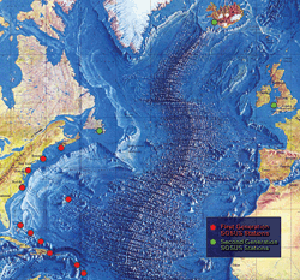
Sound Surveillance System (SOSUS) was the original name for a submarine detection system based on passive sonar developed by the United States Navy to track Soviet submarines. The system's true nature was classified with the name and acronym SOSUS classified as well. The unclassified name Project Caesar was used to cover the installation of the system and a cover story developed regarding the shore stations, identified only as a Naval Facility (NAVFAC), being for oceanographic research. The name changed to Integrated Undersea Surveillance System (IUSS) in 1985, as the fixed bottom arrays were supplemented by the mobile Surveillance Towed Array Sensor System (SURTASS) and other new systems. The commands and personnel were covered by the "oceanographic" term until 1991 when the mission was declassified. As a result, the commands, Oceanographic System Atlantic and Oceanographic System Pacific became Undersea Surveillance Atlantic and Undersea Surveillance Pacific, and personnel were able to wear insignia reflecting the mission.

The Naval Undersea Warfare Center (NUWC) is the United States Navy's full-spectrum research, development, test and evaluation, engineering and fleet support center for submarines, autonomous underwater systems, and offensive and defensive weapons systems associated with undersea warfare. It is one of the corporate laboratories of the Naval Sea Systems Command. NUWC is headquartered in Newport, Rhode Island and has two major subordinate activities: Division Newport and Division Keyport in Keyport, Washington. NUWC also controls the Fox Island facility and Gould Island. It employs more than 4,400 civilian and military personnel, with budgets over $1 billion.
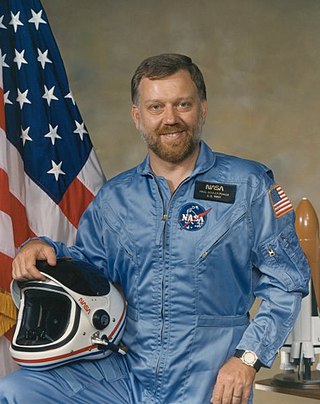
Paul Desmond Scully-Power, AM GOSE FRAeS is an Australian-born American oceanographer, technology expert, business executive and astronaut. In 1984, while a civilian employee of the United States Naval Undersea Warfare Center, he flew aboard NASA Space Shuttle mission STS-41-G as a Payload Specialist. He was the first Australian-born person to journey into space, and the first astronaut with a beard.

The Naval Postgraduate School (NPS) is a public graduate school operated by the United States Navy and located in Monterey, California.

The SOFAR channel, or deep sound channel (DSC), is a horizontal layer of water in the ocean at which depth the speed of sound is at its minimum. The SOFAR channel acts as a waveguide for sound, and low frequency sound waves within the channel may travel thousands of miles before dissipating. An example was reception of coded signals generated by the US Navy-chartered ocean surveillance vessel Cory Chouest off Heard Island, located in the southern Indian Ocean, by hydrophones in portions of all five major ocean basins and as distant as the North Atlantic and North Pacific.

An autonomous underwater vehicle (AUV) is a robot that travels underwater without requiring continuous input from an operator. AUVs constitute part of a larger group of undersea systems known as unmanned underwater vehicles, a classification that includes non-autonomous remotely operated underwater vehicles (ROVs) – controlled and powered from the surface by an operator/pilot via an umbilical or using remote control. In military applications an AUV is more often referred to as an unmanned undersea vehicle (UUV). Underwater gliders are a subclass of AUVs. Homing torpedoes can also be considered as a subclass of AUVs.

An underwater glider is a type of autonomous underwater vehicle (AUV) that employs variable-buoyancy propulsion instead of traditional propellers or thrusters. It employs variable buoyancy in a similar way to a profiling float, but unlike a float, which can move only up and down, an underwater glider is fitted with hydrofoils that allow it to glide forward while descending through the water. At a certain depth, the glider switches to positive buoyancy to climb back up and forward, and the cycle is then repeated.
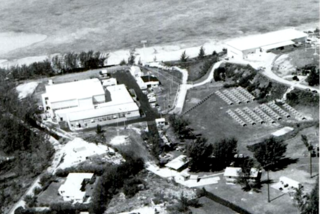
Naval Facility Bermuda, or NAVFAC Bermuda, was the operational shore terminus for one of the Atlantic Sound Surveillance System (SOSUS) array systems installed during the first phase of system installation and in commission from 1955 until 1992. The true surveillance mission was classified and covered by "oceanographic research" until the mission was declassified in 1991. The system's acoustic data was collected after the facility was decommissioned until the system was routed to the central processing facility, the Naval Ocean Processing Facility (NOPF), Dam Neck, Virginia in 1994.

Unmanned underwater vehicles (UUV), also known as uncrewed underwater vehicles and underwater drones, are submersible vehicles that can operate underwater without a human occupant. These vehicles may be divided into two categories: remotely operated underwater vehicles (ROUVs) and autonomous underwater vehicles (AUVs). ROUVs are remotely controlled by a human operator. AUVs are automated and operate independently of direct human input.
The Naval Physical and Oceanographic Laboratory or NPOL is a laboratory of the Defence Research and Development Organisation (DRDO), under the Ministry of Defence, India. It is situated in Thrikkakara, Kochi, Kerala. NPOL is responsible for the Research & Development of sonar systems, technologies for underwater surveillance, study of ocean environment and underwater materials.
The University of California Division of War Research (UCDWR) was created at Scripps Institution of Oceanography at the University of California, San Diego campus during World War II to aid the U.S. Navy in war-related research.
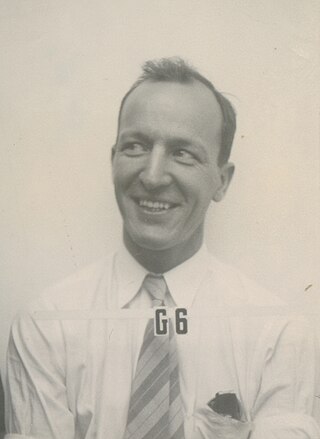
Hugh Bradner was an American physicist at the University of California who is credited with inventing the neoprene wetsuit, which helped to revolutionize scuba diving and surfing.
SPURV, or Self-Propelled Underwater Research Vehicle, was an Autonomous Underwater Vehicle built in 1957 at the University of Washington's Applied Physics Laboratory. The research and development of this vehicle was funded by the United States Office of Naval Research (ONR), and it became the US Navy’s first autonomous underwater vehicle (AUV). The navy used a total of 7 SPURV vehicles until 1979.
Liquid Robotics is an American marine robotics corporation that designs, manufactures and sells the Wave Glider, a wave and solar powered unmanned surface vehicle (USV). The Wave Glider harvests energy from ocean waves for propulsion. With this energy source, Wave Gliders can spend many months at a time at sea, collecting and transmitting ocean data.

JASCO Applied Sciences provides scientific consulting services and equipment related to underwater acoustics. JASCO operates from 7 international locations and provides services to the oil and gas, marine construction, energy, renewable energy, fisheries, maritime transport and defence sectors. The head office is located in Halifax, NS Canada. JASCO employs acousticians, bioacousticians, physicists, marine mammal scientists, engineers, technologists, and project managers.

Argus Island was an acoustic research tower and platform located on Plantagenet Bank, a guyot about 30 miles southwest of the island of Bermuda. The tower was originally part of the facilities supporting Project Artemis and Project Trident under auspices of the Tudor Hill Laboratory, a facility of the US Navy's Underwater Sound Laboratory. Later the tower was used for additional acoustic experiments as well as oceanographic observations, wave height measurements, optical observations, air containment measurements and measurements of the effects of the ocean environment on the structure itself.
Underwater Domain Awareness (UDA) is the aspect of maritime domain awareness focused on the underwater sector, including, from a security perspective, sea lines of communication (SLOC), coastal waters and varied maritime assets with reference to hostile intent and the proliferation of submarine and mine capabilities intended to limit access to the seas and littoral waters. The military requirement is not the only motivation for undersea domain awareness. The earth's undersea geophysical activities as they relate to the well-being of humans is also relevant, as monitoring such activities can provide vital clues to minimize the impact of devastating natural disasters.















